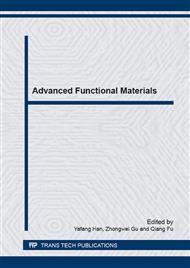[1]
J. Economy, R.A. Clark, U.S. Patent 3, 650, 102. (1968).
Google Scholar
[2]
F. Gugumus, New trends in the stabilization of polyolefin fibers, Polym. Degrad. Stab. 44(1994) 273-297.
Google Scholar
[3]
S.L. Gibson, V. Baranauskas, J.S. Riffle, U. Sorathia, Cresol novolac-epoxy networks: properties and processability, Polym. 43 (2002) 7389-7398.
DOI: 10.1016/s0032-3861(02)00538-4
Google Scholar
[4]
C.S. Tyberg, K. Bergerona, M. Sankarapandiana, P. Shiha, A.C. Loosa, D.A. Dillarda, J.E. McGratha, J.S. Rifflea, U. Sorathiab, Structure-property relationships of void-free phenolic-epoxy matrix materials, Polym. 41 (2000) 5053-5062.
DOI: 10.1016/s0032-3861(99)00574-1
Google Scholar
[5]
S.S. Tzeng, Y.G. Chr, Evolution of microstructure and properties of phenolic resin-based carbon/carbon composites during pyrolysis, Mater. Chem. Phys. 73 (2002) 162-169.
DOI: 10.1016/s0254-0584(01)00358-3
Google Scholar
[6]
N. Worasuwannarak, S. Hatori, H. Nakagawa, K. Miura, Effect of oxidation pre-treatment at 220 to 270℃ on the carbonization and activation behavior of phenolic resin fiber, Carbon. 41 (2003) 933-944.
DOI: 10.1016/s0008-6223(02)00426-8
Google Scholar
[7]
S. Imaizumi, H. Matsumoto, K. Suzuki, M. Minagawa, M. Kimura, A. Tanioka, Phenolic Resin-Based Carbon Thin Fibers Prepared by Electrospinning: Additive Effects of Poly(vinyl butyral) and Electrolytes, Polym. J. 41 (2009) 1124–1128.
DOI: 10.1295/polymj.pj2009160
Google Scholar
[8]
M.X. Wang, Z.H. Huang, F.Y. Kang, K.M. Liang, Porous carbon nanofibers with narrow pore size distribution from electrospun phenolic resins, Mater. Lett. 65 (2011) 1875-1877.
DOI: 10.1016/j.matlet.2011.03.095
Google Scholar
[9]
L. Wang, Z.H. Huang, M.B. Yue, M.Z. Li, M.X. Wang, F.Y. Kang, Preparation of flexible phenolic resin-based porous carbon fabrics by electrospinning, Chem. Eng. J. 218 (2013) 232-237.
DOI: 10.1016/j.cej.2012.12.042
Google Scholar
[10]
Y. Bai, Z.H. Huang, F.Y. Kang, Electrospun preparation of microporous carbon ultrafine fibers with tuned diameter, pore structure and hydrophobicity from phenolic resin, Carbon. 66 (2014) 705-712.
DOI: 10.1016/j.carbon.2013.09.074
Google Scholar
[11]
N. Bhardwaj, S.C. Kundu, Electrospinning: A fascinating fiber fabrication technique, Biochem. Arch. 28 (2010) 325-347.
DOI: 10.1016/j.biotechadv.2010.01.004
Google Scholar
[12]
D.L. Gee, G.E. Wnek, S.M. Zhuang, J.M. Layman, P. Lipowicz, Carbon Fibers from Electrospun Phenolic Resins and Poly(Acrylonitrile) and Their Adsorption Properties, Polym. Prepr. 44 (2003) 120-121.
Google Scholar
[13]
K. Suzuki, H. Matsumoto, M. Minagawa, M. Kimura, A. Tanioka, Preparation of Carbon Fiber Fabrics from Phenolic Resin by Electrospray Deposition, Polym. J. 39 (2007) 1128–1134.
DOI: 10.1295/polymj.pj2007091
Google Scholar
[14]
L. Wang, Z.H. Huang, M.B. Yue, M.Z. Li, M.X. Wang, F.Y. Kang, Chem. Eng. J. 218 (2013) 232-237.
Google Scholar
[15]
C. Ma, Y. Song, J.L. Shi, D.Q. Zhang, M. Zhong, Q.G. Guo, L. Liu, Phenolic-based carbon nanofiber webs prepared by electrospinning for supercapacitors, Mater. Lett. 76 (2012) 211-214.
DOI: 10.1016/j.matlet.2012.02.100
Google Scholar
[16]
C. Ma, Y. Song, J.L. Shi, D.Q. Zhang, X.L. Zhai, M. Zhong, Q.G. Guo, L. Liu, Preparation and one-step activation of microporous carbon nanofibers for use as supercapacitor electrodes, Carbon. 51 (2013) 290-300.
DOI: 10.1016/j.carbon.2012.08.056
Google Scholar
[17]
M.M. Teng, J.L. Qiao, F.T. Li, P.K. Bera, Electrospun mesoporous carbon nanofibers produced from phenolic resin and their use in the adsorption of large dye molecules, Carbon. 50 (2012) 2877-2886.
DOI: 10.1016/j.carbon.2012.02.056
Google Scholar
[18]
C.L. Liu, Y.G. Ying, H.L. Feng, W.S. Dong, Microwave promoted rapid curing reaction of phenolic fibers, Polym. Degrad. Stab. 93 (2008) 507-512.
DOI: 10.1016/j.polymdegradstab.2007.11.003
Google Scholar
[19]
D.Q. Zhang, J.L. Shi, Q.G. Guo, Y. Song, L. Liu, G.T. Zhai, Preparation Mechanism and Characterization of a Novel, Regulable Hollow Phenolic Fiber, J. Appl. Polym. Sci. 104 (2007) 2108-2112.
DOI: 10.1002/app.25787
Google Scholar
[20]
Y. Liu, F.W. Zhao, C. Zhang, J.M. Zhang, W.M. Yang, Solvrnt-free preparation of poly(lactic acid) fibers by melt electrospinning using an umbrella-like spray head and alleviation of the problematic thermal degradation, J. Serb. Chem. Soc. 77 (2012).
DOI: 10.2298/jsc110711027l
Google Scholar
[21]
D.W. Hutmacher, P. D. Dalton, Melt electrospinning, Chem. Asian J. 6 (2011) 44-56.
Google Scholar


